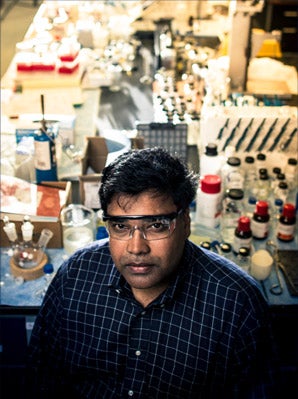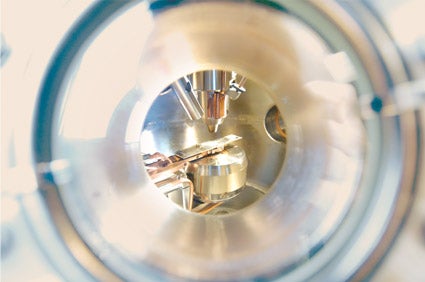Nano
Will the Science of Small Ever Have Its Big Moment?
Talking to a UCF nanoscientist about nanoscience is like chasing one person down 10 paths at the same time. Conversation veers wildly. One minute you’re talking about sunscreen, the next minute lasers. Ask a question about cell phones; get an answer about smoke alarms. And just when you think you’re heading toward rocket science, you turn a corner and run right into cancer treatment.
Welcome to the far-reaching, mind-boggling world of nanoscience.
What’s in a Nano?
For nonscientists to understand this world, they must know that a nano is not a thing, but a unit of measurement. A nanometer (nm) is defined as one-billionth of a meter. To put this in perspective, consider that the pinhead measures about 1 million nm across, a human hair about 80,000 nm in diameter, and a DNA molecule between 1–2 nm.
Strange things happen when materials reach nano size. Silver is completely nontoxic in its common form, yet nanosilver particles are capable of killing viruses on contact. Aluminum, generally considered a stable and soft metal, is combustible as a nanoparticle, and two years ago, researchers unveiled nano-engineered aluminum alloys that are stronger than steel.
Dr. Sudipta Seal, director of the NanoScience Technology Center and the Advanced Materials Processing and Analysis Center (AMPAC) at UCF, asks his classes, “When is gold not gold? When it is nanogold, which can be many different colors.”
Nanomaterials do exist in nature—volcanic ash, smoke and sea spray all contain nanoparticles. And as early as the 1600s, alchemists were using chemical reactions to create nanogold, which can still be seen in stained glass windows. But it wasn’t until the invention of the scanning tunneling microscope in 1981 that scientists could actually see what was happening and begin manipulating materials at the nano scale. The discovery of fullerenes in 1986, specially shaped carbon nanoparticles that exhibit unusual strength and conductivity, kicked off an explosion in nano research as scientists raced to uncover the true potential of these exciting materials.
Today, nanoscientists capitalize on the unique properties of nanomaterials to create new materials, systems and devices. The new Boeing 787 Dreamliners, for instance, are built with nanofiber composites that are stronger, lighter and more fuel-efficient than aluminum and steel.
Dr. Sudipta Seal holds a microchip fitted with nanoparticles.
Nanotechnology Fantasy and Fact
In his 1986 book, Engines of Creation, nanotech pioneer Eric Drexler described a scenario in which nanorobots could spiral out of control, obliterating bio-organisms as they created replicas of themselves.
The classic sci-fi series “Star Trek” featured a device known as the “replicator,” which could generate anything from a glass of wine to an electric guitar by building it directly from the molecular level—the same process used to create nanoparticles today.
Judging by the fantastic representations of nanoscience that have emerged in our culture over the years, one might presume that nanotechnology is well on its way to revolutionizing every area of our lives. The truth, at least for the time being, is far less dramatic.
In fact, ordinary citizens already see, wear and use nanotechnologies on a regular basis. The high-speed processors in modern computers and mobile phones. The LED bulbs in a traffic light. The ability to buy clothing that doesn’t wrinkle, paints that don’t fade, and sunscreen that doesn’t turn white after a few hours. All have been made possible by nanoscience.
The Project on Emerging Nanotechnologies maintains an inventory of consumer products that manufacturers identify as being “nanotechnology-enabled,” meaning they either contain nanomaterials or utilize nanotechnology. To date, more than 1,300 of these products have entered the commercial marketplace.
In the Health and Fitness category, products range from acne treatments to lightweight tennis rackets. These are certainly handy innovations. But where are the dazzling breakthroughs that live up to the hype and intrigue that have surrounded nanoscience since the early 1980s?
According to Dr. Thomas O’Neal, associate vice president of the Office of Research & Commercialization at UCF, and founder and executive director of the UCF Business Incubation Program, they’re still in the works.

Thinking Big
Dr. Sudipta Seal at the the Advanced Materials Processing and Analysis Center. The technology created here can be applied to everything from stronger concrete to more effective burn treatments.
From Research to the Real World
Some of the key discoveries made in UCF NanoScience Technology Center labs have the potential to lead to these remarkable real-world applications:
- An over-the-counter cancer test, similar to a home pregnancy test
- DVDs with triple the storage capacity
- Lithium batteries with dramatically higher energy capacity
- Robotic fingers and hands sensitive enough to perform surgery
- Super-capacitors that store much larger amounts of solar and wind power
- Faster, more accurate testing of pharmaceutical cancer therapies
- Preventive treatments for Alzheimer’s disease
- Treatments that use a patient’s own stem cells to fight Alzheimer’s, Parkinson’s, diabetes, cancer and heart disease
- A concrete-substitute that can be produced with zero carbon emissions (concrete production currently accounts for 5 percent of worldwide carbon emissions)
For more information on NSTC research, visit nanoscience.ucf.edu.

A View of Nano
NSTC and Nano’s New Frontiers
Inside the 21,000-square-foot UCF NanoScience Technology Center (NSTC), faculty members, students and research staff members are exploring nanotechnology’s vast possibilities. Nanomaterials are being used as drug delivery systems. As the building blocks of highly precise lasers. As the key to more efficient solar energy, rocket propulsion and environmental waste cleanup. The scope is so wide that you can’t help but wonder how the NSTC narrows down its field of research applicants to choose the next projects.
“We always try to see what is the next big thing needed to fuel the economy,” explained Seal. Then almost immediately, he expanded the possibilities. “We choose things to contribute to the next frontiers of science.”
According to Seal, those frontiers lie in the areas of medicine, energy, water purification, environmental cleanup and green technology. His own research focuses on the development of nanofuels and industrial materials that produce less environmental waste.
“New technologies are always trying to mimic what nature has been doing all along,” he says. “So, can we create solar panels that convert energy as efficiently as those tiny leaves create energy for a massive tree? Can we engineer cancer therapies that work as efficiently as our own cells that differentiate uncontrollably and cause cancer in the first place? That’s what our research is asking.”
Even when researchers find the answer in the labs, the road to market can take more than a decade. To date, NSTC researchers have launched six spin-off companies to advance their research from the
lab setting to marketable consumer products and patient therapies.
The process takes both time and money. While NSTC projects have received grants from several local and federal partners, including the National Institutes of Health, NASA and the Army Research Laboratory, nanotechnology funding overall is on the decline in the U.S.
O’Neal remains optimistic about the future potential of the field.
“It took 40 years for science to tap into the full potential of laser technology,” he says. “That’s how it will be with nano. The discoveries are just starting to become more prolific. People will get excited about nano again, and the funding will follow, but it won’t be because of one big thing. A bunch of small successes can add up to a pretty big change.”
For the science of small, perhaps there will be no revolution. Just an evolution of our world happening all around us, in baby steps.✦
New technologies are always trying to mimic what nature has been doing all along,” he says. “So, can we create solar panels that convert energy as efficiently as those tiny leaves create energy for a massive tree? Can we engineer cancer therapies that work as efficiently as our own cells that differentiate uncontrollably and cause cancer in the first place? That’s what our research is asking.